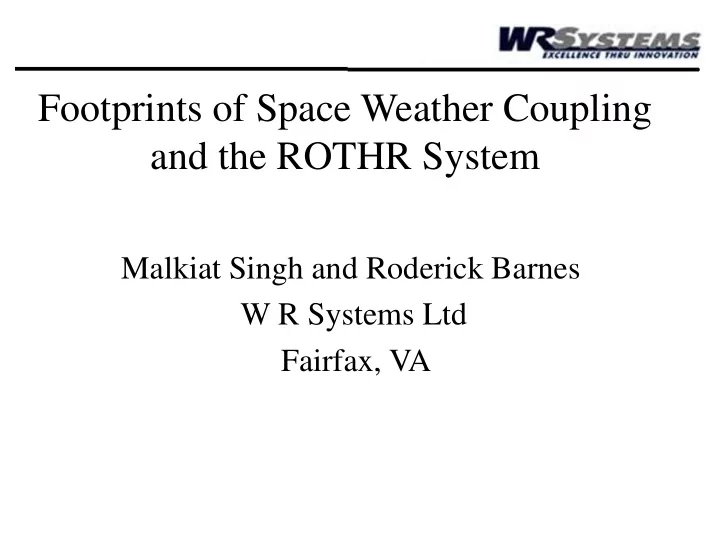

Footprints of Space Weather Coupling and the ROTHR System Malkiat Singh and Roderick Barnes W R Systems Ltd Fairfax, VA
Scope of paper Study Effects of Space Weather specifically Solar Flares and Coronal Mass Ejection (CME) on HF Communications as related to Re-locatable Over The Horizon Radar(ROTHR) A Solar Flare is an explosion that occurs on the Sun when energy stored in twisted magnetic fields (usually above sunspots) is suddenly released Solar flares produce a burst of radiation across the electromagnetic spectrum, from radio waves to x-rays and gamma rays. Solar flares are classified into three categories (X-, M-, and C-class flares) based on x-ray brightness in the 1 – 8 Å wavelength band. X-class flares have not only the largest energy (peak power > 10 -4 W m -2 ), but the effect also lasts longer and can trigger earth-wide radio blackouts Solar flares are occasionally accompanied by solar bursts. Solar bursts, which have energy at L band frequencies, also affect GPS availability/performance M-class flares are medium-sized and can cause brief radio blackouts, and effects are typically limited to Polar Regions. C-class flares have relatively unnoticeable effects on radio signals.
Solar Flares Effects are observed all over earth (dayside) simultaneously. Solar Flare is localized phenomena. Possible cause include magnetic reconnection Coronal Mass Ejection (CME) is a massive burst of gas and magnetic field from Sun Most ejections originate from active regions on the Sun's surface, such as groupings of sunspots associated with frequent flares. When the ejection is directed towards Earth and reaches it as an interplanetary CME (ICME) The shock waves of the traveling mass of solar energetic particles can cause a geomagnetic storm Solar energetic particles cause strong aurorae in large regions around Earth's magnetic poles CME effects occur first at high latitudes and then propagate to lower latitudes (e.g., TID’s)
Solar Flare • occurred on 10 th September, 2014. Pair of CMEs hit • Earth's magnetic field in quick succession on Sept. 11 th and 12 th , 2014 . During CME’s • Aurora observed from mainland USA Magnetic field • before and after CME
Relocatable Over the Horizon Radar (ROTHR) Consists of two independent components Monitor and assess the environment (Ionosphere) Environment monitored by QVI and WSBI Backscatter radar to detect & track targets
Virginia ROTHR Transmitter and Receiver separated by 158 kilometers Typical Quasi Vertical Ionogram ( QVI) looks like vertical ionogram
Wide Sweep Backscatter Ionogram (WSBI) foF2 contours in Virginia ROTHR region of operation (9-9-2014, 1900 UT) HF beams launched in 8 azimuths separated by 8 0 . Backscatter Ionograms, known as WSBI, are measured in range vs frequency format from each azimuth HF frequency operation range for ROTHR is 5 – 28 MHZ Leading edge is prominent feature od WSBI. We have ingested leading in to RIBG ionospheric model for real time updates
Solar Flare Effects on QVI QVI and WSBI measured every 12 minutes QVI just before Solar Flare No QVI’s after Solar Flare for about two hours
Solar Flares and WSBI WSBI Before and at Solar Flare The effect starts at lower frequencies
Recovery of WSBI Recovery starts at Higher Frequencies First 48 Minutes from the onset of Solar Flare
Recovery of WSBI Recovery continues from higher to lower frequencies
Recovery of WSBI and QVI Recovery after about two hours of both WSBI and QVI
CME Effects The solar charged particle effects are first observed at high latitudes (aurora, scintillations) Transferred to lower latitudes either in the form TID’s CORS network of consist of hundreds of GPS receivers which can track and determine characteristics of TID’s Some QVI and WSBI observations during CME
TID Simulator The RIBG model (raytrace through the combined models of ionospheric conductivity and electron • density (ICED), Bent, and Gallagher models) is utilized to model ionosphere. RIBG can ingest TEC ( from GPS receivers) and Ionosonde data to determine driving parameter • (e.g., effective sunspot number) to recreate the observed ionospheric conditions (Singh and Reilly ) Technique has been expanded to ingest WSBI data (leading edge measurements) • Developed simulator that produces ionosphere populated with TID’s which are function of scale size, • time period, speed, and direction Example of ionosphere populated with medium scale (150 km) TID’s in east-west directions. •
foF2 ,hmF2 in the presence of TID’s in NS and @ 135 Azimuth directions
foF2 at various stages of TID cycle ( 0, 5, 10 ,15 minutes ) for TID of 20 minute period for EW TID
Raytrace thru ionosphere with and without the presence of TID’s ( @ 16 MHz)
The raytrace thru the ionosphere in the presence of TID’s with scale sizes of 150, 250, and larger amplitude for elevation angles of 7.75 to 17.75 0 .
Summary During Solar Flares, HF propagation is virtually non existent There is no QVI or WSBI for some time HF propagation recovers at higher frequencies first. During CME, HF propagation is modified Expanded the technique to ingest WSBI data to update RIBG model Developed TID simulator which can produce TID’s as function of scale size, time-period, and velocity There is a shift in group /ground range due to TID’s. The shift can/will be correlated to shift in CR
Recommend
More recommend